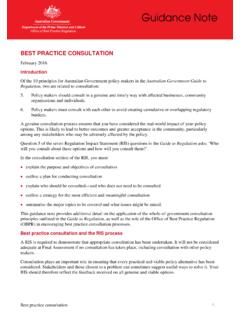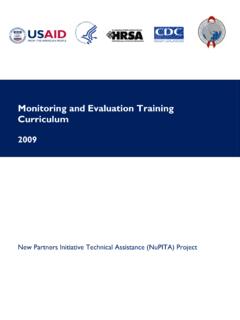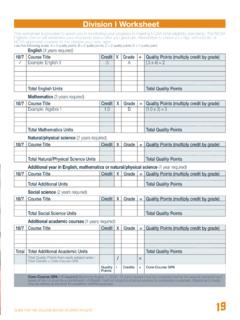Transcription of 5 Monitoring, review and evaluation - Department of the ...
1 The Cabinet Implementation Unit within the Department of the Prime Minister and Cabinet provides whole-of-government advice on implementation and delivery, with a focus on capability building, implementation assessments and progress reporting. Cabinet Implementation Unit Toolkit 5 monitoring , review and evaluation Track, measure and report your results evaluation tells you if you are on the path to success and when you ve arrived. Effective monitoring , review and evaluation provide information on emerging issues, improve performance and ensure accountability.
2 Understand the difference between monitoring , review and evaluation . Plan from the start what will be measured, how it will be measured, for what purpose and who will receive the information. Start by asking good evaluation questions: Are we doing the right thing? Are we doing it the right way? Are there better ways of achieving results? June 2013 2 Elements of effective monitoring , review and evaluation As part of the planning process, clearly define the objectives and outcomes of the policy that is being implemented. It is essential to determine what successful outcomes will look like and what evidence will be needed to demonstrate success.
3 As this has planning implications, thinking needs to occur from the outset and ensure activities are fit-for-purpose. Other important elements include: Report to others: There needs to be a clear purpose and demand for undertaking monitoring , review and evaluation activities. Information produced from this process must be targeted for specific audiences and be incorporated into the governance arrangements in order to enhance transparency and accountability. Activities that occur isolated from decision-making or commence after implementation is complete are of limited value to initiative participants.
4 Involve stakeholders: All relevant stakeholders need to be engaged for monitoring , review and evaluation activities to be successful. Clearly communicating the benefits of activities and providing the necessary support creates opportunity for willing participation and ownership. An open process that allows stakeholders access to information increases credibility. Monitor progress: Successful monitoring delivers timely and relevant information that allows you to track progress towards outcomes and make adjustments to implementation arrangements as necessary.
5 Track progress in a deliberate and systematic manner at regular intervals during implementation. Implementation planning must define the data to be collected and the method used for monitoring . Obtaining advice from experts in data collection during the planning process will contribute to a robust and credible methodology. monitoring will inform other components of implementation such as risk management. review regularly: Factor in reviews as part of your planning process to assess progress of implementation at critical milestones or in response to specific issues.
6 Reviews are a snapshot in the life of an initiative and tend to focus on operational issues, effectiveness of governance and project management structures, and may also include policy outcomes. Findings and recommendations from reviews should be used to improve implementation. Evaluate the outcomes: The success of an initiative is determined by the extent to which intended and unintended policy outcomes are achieved and how they have affected stakeholders. planning for evaluation should identify and map baseline information as well as ensure that ongoing access to consistent data sources will be available through monitoring over the life of the initiative.
7 Data can be quantitative (hard or numerical data) or qualitative (soft or categorical). Those managing an evaluation need to focus on asking good questions to assess the data collected. Credibility of an evaluation is enhanced through sound evidence, professional and ethical standards, and the degree of independence of the evaluator. Effective evaluation is the result of a planning process over the life of the initiative. 3 Hurdles to effective monitoring , review and evaluation Specific hurdles that may adversely impact the effectiveness of monitoring , review and evaluation from the outset include: Inadequate resourcing Successful monitoring , review and evaluation activities require adequate resourcing and early planning .
8 Resources to establish a methodology for collecting and maintaining data, conducting the reviews and evaluations and engaging stakeholders will need to be addressed in the implementation plan. The more complex and higher risk the initiative the more upfront planning will be required. Resourcing must take into account the full costs of activities to all participants for the full duration of the initiative. Resist the temptation to use money set aside for review and evaluation to fill emerging resource gaps during implementation. While independent reviews and evaluations can enhance credibility, adequate resourcing must also be allocated to ensure correct and consistent data is collected to support quality findings.
9 Lack of a systematic planning approach Without a systematic planning approach in place, it can be difficult to understand how processes and activities will contribute to intended outcomes, and how they will be measured along the way. An effective approach identifies all the main components of an initiative and plans out all the activities as a cause-and-effect chain and sets out what is to be monitored, reviewed and evaluated. It generally includes objectives, inputs, processes, activities, outputs and outcomes. When done thoroughly, a systematic planning approach can identify gaps and highlight the importance of particular activities.
10 Choose a planning methodology that best suits the initiative and draw on available resources and information that will be needed to conduct any analysis. There are a number of methods for systematic planning including program logic and the logical framework approach. It may be necessary to source training for staff or engage external expertise if the skills and capacity to conduct a planning process are not available internally. Include these costs as part of the implementation planning . Irrelevant or insufficient data Any number of problems can arise when the data collected as part of the monitoring activity is not relevant or able to measure the expected outcomes of the initiative.













